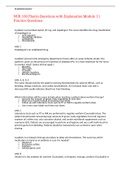Exam (elaborations)
NUR 100 Pharm Questions with Explanation Module 11 Practice Questions,100% CORRECT
NUR 100 Pharm Questions with Explanation Module 11 Practice Questions
A patient is prescribed aspirin, 81 mg, and clopidogrel. The nurse identifies the drug classification of clopidogrel as
A. anticoagulant.
B. thrombotic inhibitor.
C. antiplatelet.
D. thrombolytic.
ANS: C
Clopidogrel ...
[Show more]
Preview 3 out of 21 pages
-
March 24, 2023
-
21
-
2022/2023
-
Exam (elaborations)
-
Questions & answers
81 mg
a patient
nur 100 pharm questions with explanation module 11 practice questions
a patient is prescribed aspirin
and clopidogrel the nurse identifies the drug classification of clopidogrel as
All documents for this subject (146)
PHARMOCOLOGY
NUR 100 Pharm Questions with Explanation Module 11
Practice Questions
A patient is prescribed aspirin, 81 mg, and clopidogrel. The nurse identifies the drug classification
of clopidogrel as
A. anticoagulant.
B. thrombotic inhibitor.
C. antiplatelet.
D. thrombolytic.
ANS: C
Clopidogrel is an antiplatelet drug.
A patient arrived in the emergency department 2 hours after an acute ischemic stroke. The
patient is given an intravenous (IV) injection of alteplase tPA. It is most important for the nurse
to monitor what? (Select all that apply.)
A. Bleeding
B. Vital signs
C. PT levels
D. Allergic reactions
E. Electrocardiogram
ANS: A, B, D, E
The nurse should monitor the patient receiving thrombolytics for adverse effects, such as
bleeding, allergic reactions, and cardiac dysrhythmias. An increased heart rate with a
decreased BP usually indicates blood loss from bleeding.
Which information will the nurse include when teaching a patient about warfarin therapy?
A. Increase the amount of green, leafy vegetables in your diet.
B. Rinse your mouth instead of brushing your teeth.
C. Follow up with laboratory tests such as PT or INR to regulate warfarin dose.
D. Use a new razor blade each time you shave.
ANS: C
Laboratory tests such as PT or INR are performed to regulate warfarin (Coumadin) dose. The
patient should avoid consuming large amounts of green, leafy vegetables; broccoli; legumes;
soybean oil; coffee; tea; cola; excessive alcohol, and certain nutritional supplements such as
coenzyme Q10. Patients are encouraged to perform oral hygiene and use a soft tooth brush to
prevent gums from bleeding. Patients should be instructed to use an electric razor when
shaving.
A patient is on heparin therapy secondary to deep vein thromboses. The nurse has which
medication on hand as an antidote in case it is needed?
A. Vitamin K
B. Protamine sulfate
C. Warfarin
D. Aminocaproic acid
ANS: B
Vitamin K is the antidote for warfarin (Coumadin), not heparin, therapy; warfarin (Coumadin) is
,PHARMOCOLOGY
an anticoagulant, and aminocaproic acid (Amicar) is a plasminogen inactivator used to control
excessive bleeding from hyperfibrinolysis.
Four patients are considered as potential candidates for thrombolytic therapy. Which patient is
most likely to receive thrombolytic therapy?
A. The patient who recently used acetaminophen
B. The patient with a history of severe hypertension
C. The patient who recently had spinal surgery
D. The patient with a history of warfarin use
ANS: A
Acetaminophen (Tylenol) does not interfere with the coagulation system. Contraindications for
use of thrombolytics include a recent CVA, active bleeding, severe hypertension, recent history
of traumatic injury, especially head injury, and anticoagulant therapy. The nurse should report if
the patient takes aspirin or NSAIDs.
The nurse is caring for a patient who received alteplase tPA for treatment of acute coronary
syndrome. The patient starts to bleed. The nurse anticipates administration of which
medication?
A. Protamine sulfate
B. Vitamin K
C. Warfarin
D. Aminocaproic acid
, PHARMOCOLOGY
ANS: D
Aminocaproic acid (Amicar) is used to stop bleeding by inhibiting plasminogen activation, which
inhibits thrombolysis.
A patient visits an outpatient clinic. The patient has been noncompliant with anticoagulation
therapy and states, “I don’t like having to have blood work all of the time.” The nurse
anticipates prescription of which medication?
A. Abciximab
B. Tirofiban
C. Eptifibatide
D. Rivaroxaban
ANS: D
Two oral anticoagulants form a new anticoagulant category called Xa inhibitors. Rivaroxaban
(Xarelto) was FDA-approved in July 2011, and apixaban (Eliquis) was FDA-approved in
December 2012. These drugs do not require routine coagulation monitoring and are given q.d.
or b.i.d. The other medications are administered intravenously.
A patient is recovering from surgery to replace her right hip. In the early postoperative phase,
the nurse anticipates administration of which drug to prevent deep vein thrombosis?
A. Dipyridamole
B. Low-molecular-weight heparin
C. Abciximab
D. Anagrelide
ANS: B
Low-molecular-weight heparins are derivatives of standard heparin and were introduced to
prevent venous thromboembolism. The other drugs are platelet inhibitors. Antiplatelets are
used to prevent thrombosis in the arteries by suppressing platelet aggregation.
The patient develops a deep vein thrombosis. The nurse anticipates administration of which
medication?
A. Intravenous heparin
B. Clopidogrel
C. Vitamin K
D. Protamine sulfate
ANS: A
Intravenous heparin is indicated for rapid anticoagulant effect when a thrombosis occurs
because of a deep vein thrombosis (DVT), pulmonary embolism (PE), or an evolving stroke. The
effects of subcutaneous heparin take longer to occur. Clopidogrel (Plavix) is an antiplatelet drug
that is mainly for prophylactic use in prevention of myocardial infarction or stroke. Vitamin K is
the antidote for warfarin, and protamine is the antidote for heparin.
The patient is being discharged home on warfarin therapy. Which information will the nurse
include when teaching the patient?
A. Results of activated partial thromboplastin time (aPTT) will determine if the medication is
effective.
B. International normalized ratio (INR) results should be between 2 and 3.
C. A normal response to warfarin is for your stools to look tarry.




